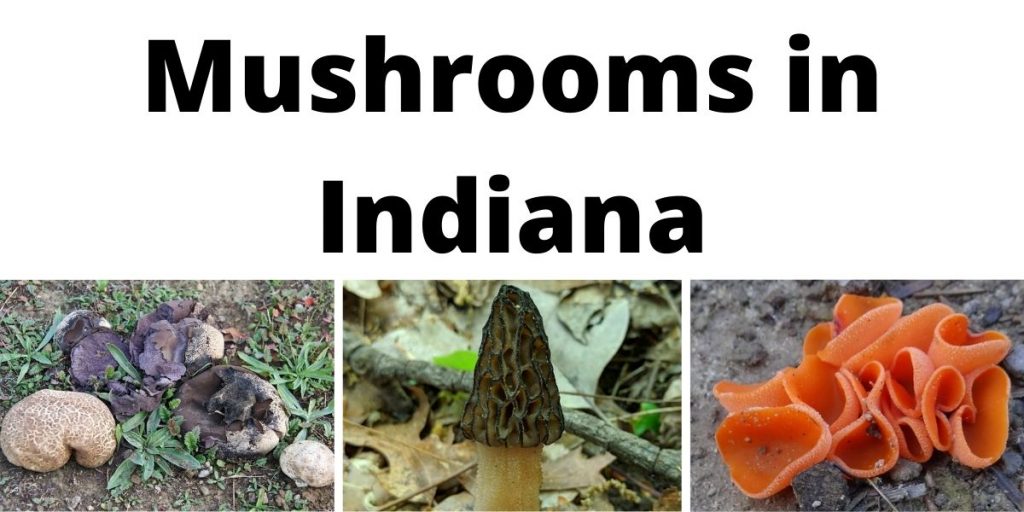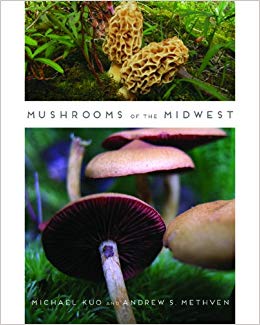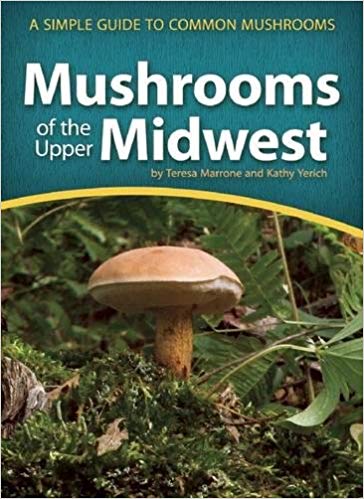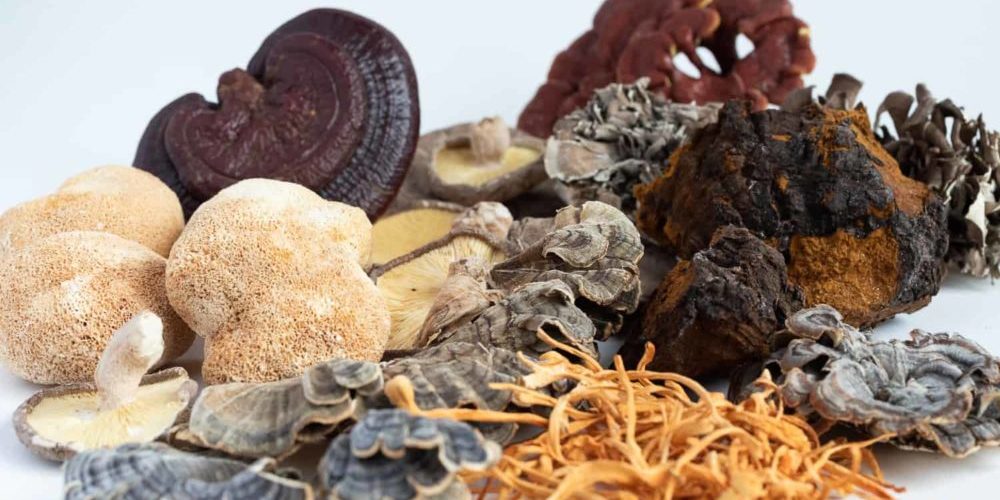No list of Indiana mushrooms can be complete for an article like this—there are far too many mushroom species in the state[i]. But there are other places you can go for complete lists and full treatments. What we’re trying to do here is give you a taste of what’s out there, to give you a reason for wanting to find out more.
Our Recommended Field Guides for Indiana
COVER | TITLE | Header | ||
|---|---|---|---|---|
OUR #1 RATED | ||||
Edible Wild Mushrooms in Indiana
Foraging for wild mushrooms is not as difficult as it’s sometimes made out to be—but that doesn’t mean you should go out foraging on the say-so of an introductory article like this one. Mushroom identification requires knowledge, experience, and diligence. It’s not hard if you know what you are doing and do it carefully, but even experts sometimes get into trouble by skipping steps and making assumptions. Beginners are simply too likely to make assumptions without realizing it; you don’t know what you don’t know.
It’s never too early (or too late) to start to learn. If you do indeed go Mushroom Hunting make sure you have the proper tools, take a quality knife with you and a basket/bag for your haul!
This list is not meant to be used as a replacement for a field guide, spore prints, an identification app or an in person guide.
Meadow Mushroom (Agaricus campestris)
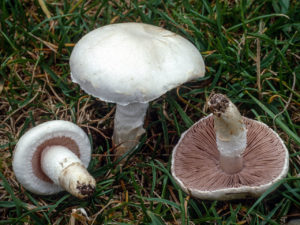

Here we have a wild cousin of the domestic mushroom (whose common name actually is “mushroom”) often sold under names like white button, crimini, or portobello. The wild version is whitish with pink to brown gills and dark brown spores[ii]. Like its cousin, this species produces edible fruiting bodies that work well in soups and stews and on pizza. Being white, they are sometimes mixed up with destroying angels, a potentially deadly mistake best avoided by careful attention to detail.
Chanterelles
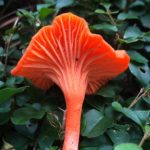

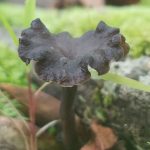

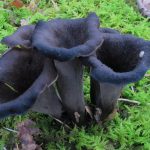

Chanterelles are a group of closely-related and very distinctive-looking mushrooms. They don’t exactly have caps the same way that, for example, Agaricus mushrooms do. Instead, what is called their cap is generally more like an extreme expansion of the stem, like the bell of a trumpet. The outside of the bell may be smooth or ridged, and either way bears the spores. Although Cantharellus is considered the chanterelle genus, the trumpets of the closely-related Craterellus genus are very similar and are sometimes called chanterelles also. The entire group is edible, varying from merely good to excellent. They have toxic look-alikes, but with attention to detail, telling the difference isn’t difficult.
Indiana has at least five Cantharellus species, all but one of them yellow, though varying in shape and size. The one exception to the yellow, the Cinnabar-Red Chantarelle (C. cinnabarinus), is variable but always one or another shade of red. There are also at least two Craterellus species, both of them blackish, and fittingly both called black trumpets—C. calyculus and C. fallax.
Puffballs
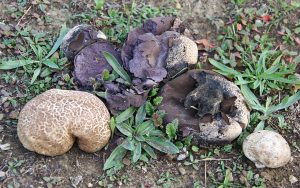

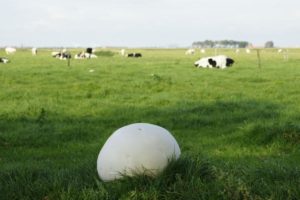

“Puffballs” are not a genus or a family of mushrooms, they’re just a collection of not-closely-related species that happen to all be ball-shaped[iii]. That being said, Indiana’s two puffballs (there may be others) do belong to the same genus and thus are related[iv]: the Purple-Spored Puffball (Calvatia cyathiformis) and the Giant Puffball (Calvatia gigantea). Both are large to very large, differing in shape, surface texture, and spore color. Both are prized edibles when young, while the spore mass is still white. The large size makes confusion with toxic look-alikes (Earthballs blackhatworld.comand the egg stage of Amanitas) less likely than for the smaller puffballs—though it’s still important to check identification carefully.
Morels (Morchella sp.)
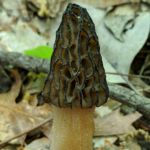

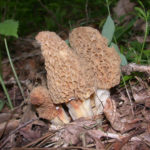

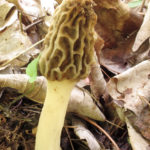

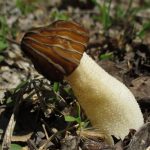

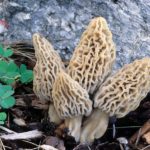

Morels have an undeserved reputation as easy to identify and always safe to eat. They have a well-deserved reputation for being delicious. It’s true that determining whether something is a morel is fairly easy—the narrow, pitted caps are distinctive, and while there are false morels of various kinds, these are seldom eaten through mistaken identity (people eat false morels on purpose, and often, but not always, get poisoned as a result). But morels are almost impossible to identify to species in the field—some kinds are so variable they were until recently thought to be multiple species, while others are so alike that several were thought to be a single species[v].
More problematic is that morels (like false morels, though perhaps not to the same extent) sometimes make eaters sick, even after having been properly cooked. No one’s really sure why some people can eat morels safely and others can’t. In the meantime, most people are at least in agreement that they are excellent in cream sauce.
Indiana has at least five morel species: M. angusticeps, M. esculentoides, M. diminutiva, M. punctipes, and M. rufobrunnea.
Ink-Caps
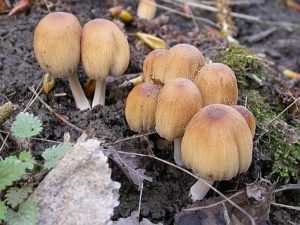



Indiana has several closely-related genera of ink-caps, mushrooms that release their spores by dissolving into ink. While some are toxic or of unknown edibility or just too small to bother harvesting, some are edible—provided the eater abstains from alcohol while eating and for several days afterwards.
The Mica Cap (Coprinus micaceus)[vi] reportedly tastes quite good, though some dislike the texture. The larger Inky Cap (Coprinopsis atramentaria)[vii] is darker and grayer in color.
Edible Amanitas
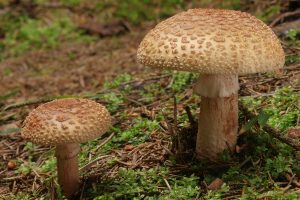

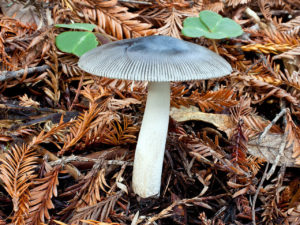

The Amanita genus is represented by almost two dozen species in Indiana. Some are deadly-poisonous—in fact, the genus is famous for its poisonous members, to the point that some experts recommend never eating any Amanita, because if the risk of eating the wrong one. But some of Indiana’s Amanitas are only mildly toxic, some are of unknown toxicity, and some are actually edible.
The Blusher (A. rubescens)[viii], for example, varies dramatically in size and color, but always turns red when cut. It is considered safe to eat if (and only if) it is first well-cooked. The Grisette (A. vaginata)[ix] is a pretty, gray mushroom, edible, though not considered choice. There may be others. Just don’t risk eating the wrong one.
Orange Peel Fungus (Aleuria aurantia)
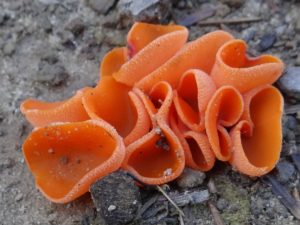

The orange peel[x] is a cup-fungus that does, in fact, look very much like a piece of orange peal. It has some toxic look-alikes and is reportedly nearly tasteless, but it is safe to eat, and so we’re including it–because simply the idea of eating something this odd-looking has a certain charm.
Our Recommended Field Guides for Indiana
COVER | TITLE | Header | ||
|---|---|---|---|---|
OUR #1 RATED | ||||
Poisonous Mushrooms in Indiana
This list of poisonous species isn’t exhaustive—don’t assume something is edible just because it’s not listed here! If you or someone you are with might have eaten a poisonous mushroom, get medical attention immediately. Call a poison control center to start with. Proper treatment will depend on proper diagnosis, since there are many different forms of mushroom poisoning, and the treatment for each is different. Bring a sample of the mushroom with you to the emergency room if at all possible so that the medical staff can confirm the identification and the diagnosis as quickly as possible.
Toxic Amanitas
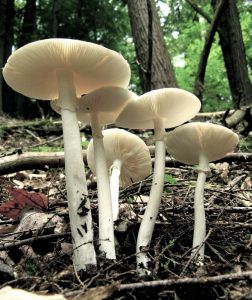

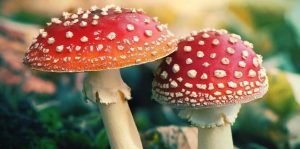

Indiana’s most seriously toxic Amanita is likely A. bisporigera, one of the Destroying Angels[xi]. The destroying angels are a group of very similar-looking large, handsome, white or whitish mushrooms that kill most of the human beings who eat them. Usually the problem is mistaken identity—although destroying angels are quite distinctive as a group, it’s not unusual for people to overlook key identification clues and mistake them for virtually any large, white, edible mushroom with gills. In the early “egg” stage, they can be mistaken for puffballs, again if key clues are missed. The amatoxin in the mushroom will then wait a day or so (the delay makes diagnosis harder) before causing serious gastrointestinal upset for a few days. Then symptoms resolve spontaneously. Then the kidneys and sometimes the liver fail. Poisoning victims can sometimes be saved through prompt medical treatment.
Not all toxic Amanitas are deadly, and not all contain the same toxins, though of course any toxic mushroom is best avoided! One not (usually) deadly species worth knowing about is Fly Agaric (A. muscaria), simply because people who eat it usually do so intentionally—because it’s psychoactive. In fact, in some articles we have listed A. muscaria among the magic mushrooms, and we may do so again in future articles. This time we’re putting it here to emphasize the fact that it is not just psychoactive—if not processed properly first, this mushroom will make users extremely ill.
Deadly Galerina (Galerina marginata)
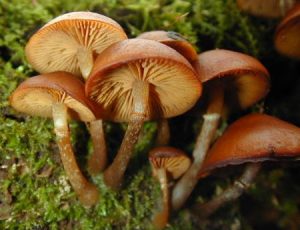

There are other mushrooms that contain deadly amatoxin, besides the Amanitas. The aptly-named Deadly Galerina[xii] is a particularly scary example[xiii]. It looks like, and in fact sometimes pops up among, several popular edible or psychoactive species. Always identify every single mushroom precisely before eating.
Dapperlings (Lepiota sp.)
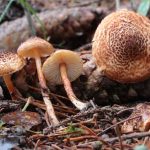

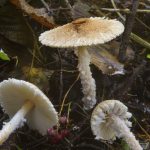

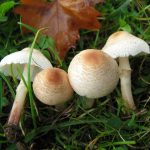

The Dapperlings, sometimes also called parasols (though distinct from the larger, edible parasols), are another group that includes some deadly-poisonous members thanks to amatoxin. They are pretty little whitish or brownish mushrooms. Indiana has at least three species. The Chestnut Dapperling (L. castanea) is definitely deadly-poisonous[xiv]. The Shield Dapperling (L. clypeolaria) is definitely poisonous but may or may not be deadly[xv]. The Stinking Dapperling (L. cristata) may or may not be poisonous, but there is no reason to attempt to find out through personal experience[xvi].
Cortinarius Mushrooms
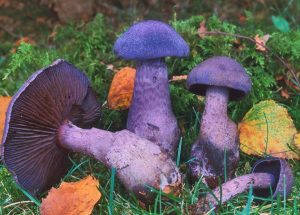

Here we have a genus of mushrooms that includes some deadly-poisonous species, some not-deadly, but still-poisonous species, and a few that are either not poisonous or are of unknown status. However, so adamant are most experts that no cort should ever be eaten that it’s very difficult to find out whether any of Indiana’s six species might be safe. Part of the problem is that telling one species from another is very hard. Also, this is another frighteningly difficult-to-diagnose form of poisoning, since there can be a very long period before symptoms develop, and symptoms may go away for a time—so, not a mushroom anyone wants to take any risks with. The toxin responsible is not amatoxin, and it functions in a different way, but it, too, can do irreversible damage to the kidneys[xvii].
Cortinarius[xviii] mushrooms come in many different colors, but they have in common a cobwebby partial veil that tears at maturity, often leaving little to no remnant.
False Parasol (Chlorophyllum molybdites)
“False parasol” is a bit of a misnomer, as it implies that this species is a toxic look-alike of the edible parasols. The truth is not quite so simple. This species is a member of the shaggy parasol group, whose mushrooms vary from mostly-safe to mostly-not-safe along a continuum of species whose names seem to get mixed-up and misspelled with confusing regularity. C. molybdites is the most reliably toxic member of the group and is distinguishable from the others by its green spores. However, some of the others, while generally considered edible, sometimes sicken eaters—and may even develop green spores.
The members of the shaggy parasol group do not kill eaters, but they could easily be mixed up with some that can, either the destroying angels or the dapperlings[xix].
Tar-Scented Mushroom (Agaricus placomyces)
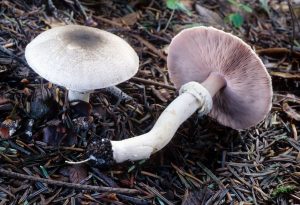

This species seems not to have a common name of its own. Might we therefore suggest “tar-scented mushroom,” as it looks very much like the domestic mushroom (which is just called “mushroom”) but smells like coal-tar and stains yellow when cut[xx]. Also, “tar-scented” doesn’t sound very appetizing–very fitting for this, a mildly but definitely toxic species[xxi].
Our Recommended Field Guides for Indiana
COVER | TITLE | Header | ||
|---|---|---|---|---|
OUR #1 RATED | ||||
Magic Mushrooms in Indiana
Indiana has almost a dozen psilocybin-containing mushroom species[xxii], not counting the additional species no doubt growing in secret indoor gardens. Unfortunately, using or even possessing these mushrooms is illegal, not just at the Federal level, but also at the state level[xxiii]. The other caution to remember is that although psilocybin is one of the safest ways available to get altered, it isn’t without risk. Those who find a solution to the legal issue and seek to use these mushrooms need to learn and follow guidelines for physical and mental safety.
Gymnopilus
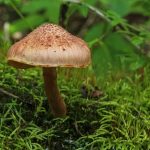



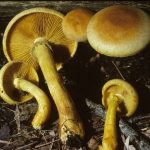

Reportedly, Indiana has three psychoactive members of this genus (G. braendlei, G. luteofolius, and G. luteus), but taxonomy among the gyms is a bit muddled, so it’s hard to be sure. These mushrooms are not well-known among psychonauts, so published trip reports are hard to come by—but in general, gyms are said to provide a qualitatively different high than most other psilocybin mushrooms do[xxiv].
Panaeolus


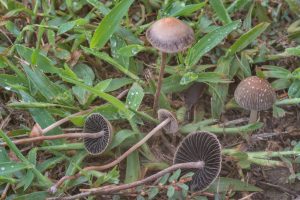

The Panaeolus [xxv] genus includes some very powerfully psychoactive mushrooms—none of which have been found growing wild in Indiana. What Indiana has is a moderately potent species, the Banded Mottlegill (P. cinctulus), and a marginally psychoactive species that is also somewhat toxic, the Turf Mottlegill (P. fimicola).
Psilocybe
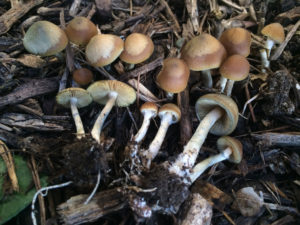

The Big Blue-Foot (Psilocybe ovoideocystidiata), a medium-strong-potency psychoactive mushroom, is the one member of this genus confirmed growing wild in Indiana. There may be others. The name reflects the bluish staining at the base of the stem.
Other Magic Genera
Indiana has several other psychoactive species in the genera Pholiotina, Pluteus, and Inocybe, but they are quite rare and almost never used.
References:
[i] (n.d.). Species List. Indiana Mushrooms
[ii] (n.d.). Meadow Mushroom. Missouri Department of Conservation
[iii] Kuo, M. (2008). Puffballs. The MushroomExpert
[iv] Kuo, M. (2016). Calvatia cyathiformis. The MushroomExpert
[v] Kuo, M. (2012). The Morchellaceae: True Morels and Verpas. MushroomExpert
[vi] Wood, M., Stevens, F. (n.d.). California Fungi—Coprinellus micaceus. The Fungi of California
[vii] Wood, M., Stevens, F. (n.d.). California Fungi—Coprinellus atramentaria. The Fungi of California
[viii] (n.d.). Amanita rubescens Pers.–Blusher. First Nature
[ix] (n.d.). Amanita vaginata (Bull.) Fr.–Grisette. First Nature
[x] (n.d.). Aleuria aurantia (Pers.) Fuckel—Orange Peel Fungus. First Nature
[xi] (n.d.). Amanita bisporigera. Amanitaceae.org WPA Mushroom Club
[xii] (n.d.). Deadly Galerina (Galerina marginata (Batsch) Kühner 1935. Maryland Biodiversity Project
[xiii] (n.d.). Galerina marginata (Batsch) Kühner—Funeral Bell. First Nature
[xiv] (n.d.). Lepiota castanea. Wikipedia
[xv] (n.d.). Lepiota clypeolaria. Wikipedia
[xvi] (n.d.). Lepiota cristata. Wikipedia
[xvii] Clarke, D., Crews, C. (2014). Hazards and Diseases. Encyclopedia of Food Safety
[xviii] (n.d.). Cortinarius. Wikipedia
[xix] (n.d.). Lepiota subincarnata J.E. Lange—Fatal Dapperling. First Nature
[xx] Kuo, M. (2018). Agaricus placomyces. The MushroomExpert
[xxi] (n.d.). Agaricus placomyces. Wikipedia
[xxii] (n.d.). Which Psilocybin Mushrooms Grow Wild in My Area? Shroomery
[xxiii] (2022). Are Psychedelics Legal in Indiana Yet? Tripsitter
[xxiv] Psycho Gnome (2014). Gymnopolus luteus found in Wisconsin (With Trip Report). Shroomery

